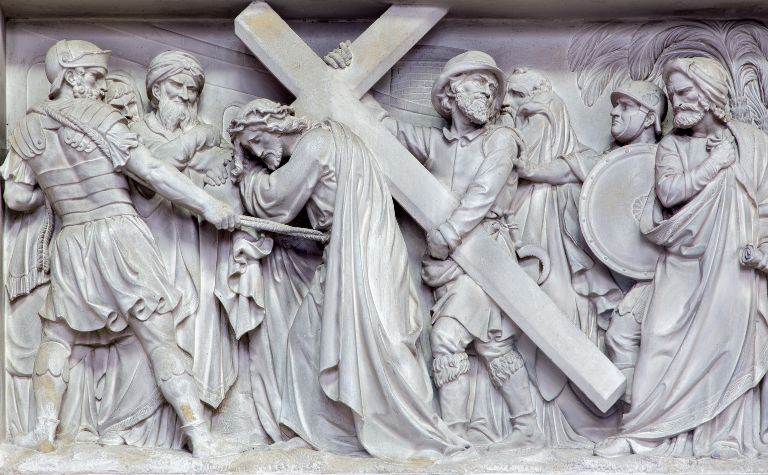The crucifixion of Jesus Christ is one of the most dramatic moments in the Bible. Along with Jesus’ resurrection, it’s the climactic moment of all four Gospels in the New Testament. Yet, surprisingly, an unexpected figure entered the scene when Jesus became physically unable to carry his cross. Who helped Jesus carry his cross to Golgotha?
Matthew, Mark, and Luke report that Simon of Cyrene helped Jesus Christ carry his cross. Simon was traveling to Jerusalem from the country as a passerby when the civil authorities drafted him to the task. Simon, not to be confused with Simon Peter, was from the North African city of Cyrene.
How could soldiers compel Simon to carry the cross? Why is Simon referred to as “of Cyrene”? Who are Alexander and Rufus? Where was Cyrene? How many Simons does the New Testament mention? Keep reading to learn the answers to these questions and others.
Also see Why Was Jesus Christ Crucified? to learn more.

What do the Gospels say about Simon of Cyrene?
The Gospels don’t reveal much about the man who helped Jesus carry his cross. Yet, it’s clear from the context of the passages that mention Simon that Jesus needed his help. Before Roman soldiers led Jesus away to crucify him, they placed a painful crown of thorns on his head (Matt. 27:29) and beat him in the head, too (Matt. 29:30).
Jesus was also physically assaulted the previous night. The authorities “spit in his face and struck him. And some slapped him, saying, ‘Prophesy to us, you Christ! Who is it that struck you?'” (Matt. 26:67). Jesus must have been in pain and extremely exhausted when it came time to carry his cross to Golgotha. The authorities made a passerby carry the cross for him to expedite arriving at the scene of his crucifixion.
- Matthew 27:32 reads, “As they went out, they found a man of Cyrene, Simon by name. They compelled this man to carry his cross.”
- Mark 15:21 reads, “And they compelled a passerby, Simon of Cyrene, who was coming in from the country, the father of Alexander and Rufus, to carry his cross.”
- Luke 23:26 reads, “And as they led him away, they seized one Simon of Cyrene, who was coming in from the country, and laid on him the cross, to carry it behind Jesus.”
How could soldiers compel Simon to carry the cross? New Testament scholar Mark Strauss explains that soldiers could make civilians perform certain tasks: “The soldiers ‘forced’ or ‘conscripted’ Simon to take it. Conscription was a common practice in the Roman military, whereby civilians could be enlisted for menial tasks.” [1] If Simon had refused the soldiers, he likely would have been arrested for a crime.
Why is Simon referred to as “of Cyrene”? Matthew, Mark, and Luke all call the man Simon. They also identified his hometown, perhaps in part to distinguish him from Simon Peter and the others Simons mentioned in the New Testament (more below). Mark and Luke add the detail that Simon was coming into Jerusalem from the country, but it’s unknown if his starting place was Cyrene or elsewhere.
Why does Mark mention Alexander and Rufus? Mark also mentions the names of two of Simon’s sons, Alexander and Rufus, which has significance. As Richard Bauckham explains in his book, Jesus and the Eyewitnesses, “The reference to Alexander and Rufus certainly does presuppose that Mark expected many of his readers to know them, in person or by reputation, as almost all commentators have agreed.” [2]
Bauckham goes on to explain that Mark may have been signaling to his original readers that people they knew were eyewitnesses to the crucifixion of Jesus or had immediate family members who were.
Does Paul mention Rufus? Some scholars believe that the Rufus Paul greets in Romans is the one Mark mentions. “Greet Rufus, chosen in the Lord; also his mother, who has been a mother to me as well” (Rom. 16:13). Other scholars think there isn’t enough evidence to come to a definitive conclusion.
Also see Where Was Jesus Chris Crucified? to learn more.

What is the significance of Cyrene?
The Gospels writers who mention Simon identify his hometown in large part to distinguish him from other Simons, such as Simon the Leper and Simon the Zealot (more below). The town of Cyrene itself isn’t important to the crucifixion narratives.
Cyrene was a city in Libya, a country west of Egypt, in North Africa. The name “Simon” is Hebrew in origin, which means he was most likely part of the Jewish community in Cyrene. Later Christian traditions outside the New Testament also identified Simon as Jewish. The Old Testament doesn’t mention the city.
Why does Acts mention Cyrene? Outside of the references to Simon in the Gospels, the town is mentioned two other times in the New Testament, both in the book of Acts.
The first reference in Acts is in the passage about Pentecost. This scene included people from the north African town: “Phrygia and Pamphylia, Egypt and the parts of Libya belonging to Cyrene, and visitors from Rome” (Acts 2:10).
Another passage in Acts mentions people from Cyrene preaching the gospel of Jesus Christ.
“Now those who were scattered because of the persecution that arose over Stephen traveled as far as Phoenicia and Cyprus and Antioch, speaking the word to no one except Jews. But there were some of them, men of Cyprus and Cyrene, who on coming to Antioch spoke to the Hellenists also, preaching the Lord Jesus” (Acts 11:19-20).
Also see What Is the Gospel of Jesus Christ? to learn more.

How many Simons are mentioned in the New Testament?
There are seven Simons mentioned in the New Testament, mostly in the Gospels. New Testament writers help readers distinguish between them by adding a short description of each one.
| Simon | Example references |
|---|---|
| Simon Peter | Matthew 4:18; Mark 3:16; Luke 24:12 |
| Simon the Zealot | Matthew 10:4; Mark 3:18; Luke 6:15; Acts 1:13 |
| Simon, the brother of Jesus | Matthew 13:55; Mark 6:3 |
| Simon the leper | Matthew 26:6; Mark 14:3 |
| Simon of Cyrene | see above |
| Simon, a Pharisee | Luke 7:36-44 |
| Simon, father of Judas Iscariot | John 6:71; John 13:2; John 13:26 |
Also see Why Did Judas Iscariot Betray Jesus? to learn more.
References:
[1] Mark by Mark Strauss. ZECNT. p. 688-689.
[2] Jesus and the Eyewitness by Richard Bauckham. p. 52.
Related Questions
Bible readers love the Gospel of John, partly because the stories within it are powerful yet easy to understand. However, a certain description, which appears in multiple stories, confuses many...
From a cross to a fish to a dove, there are many visual emblems of the Christian faith. Many reflect biblical truth about God the Father, his son Jesus Christ, or the Holy Spirit. Others represent...
